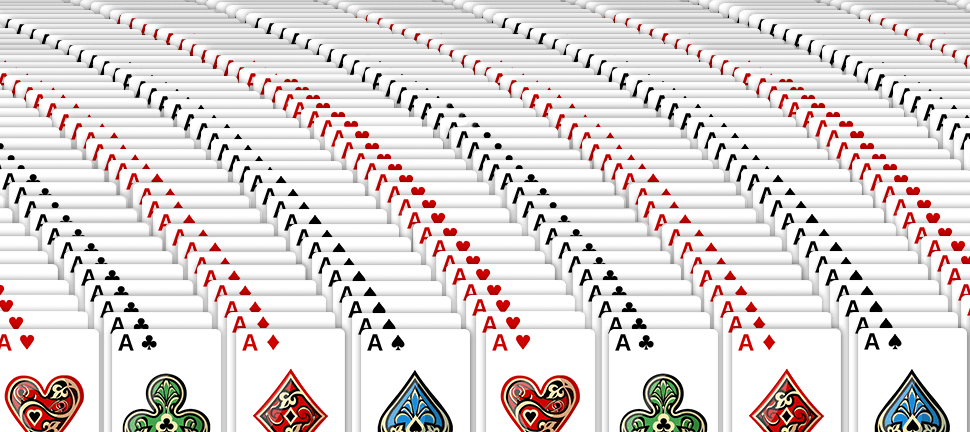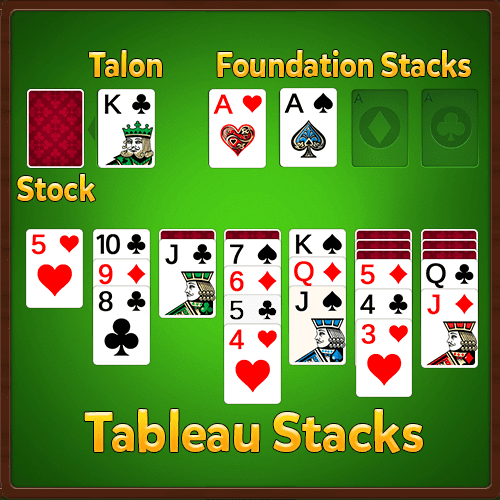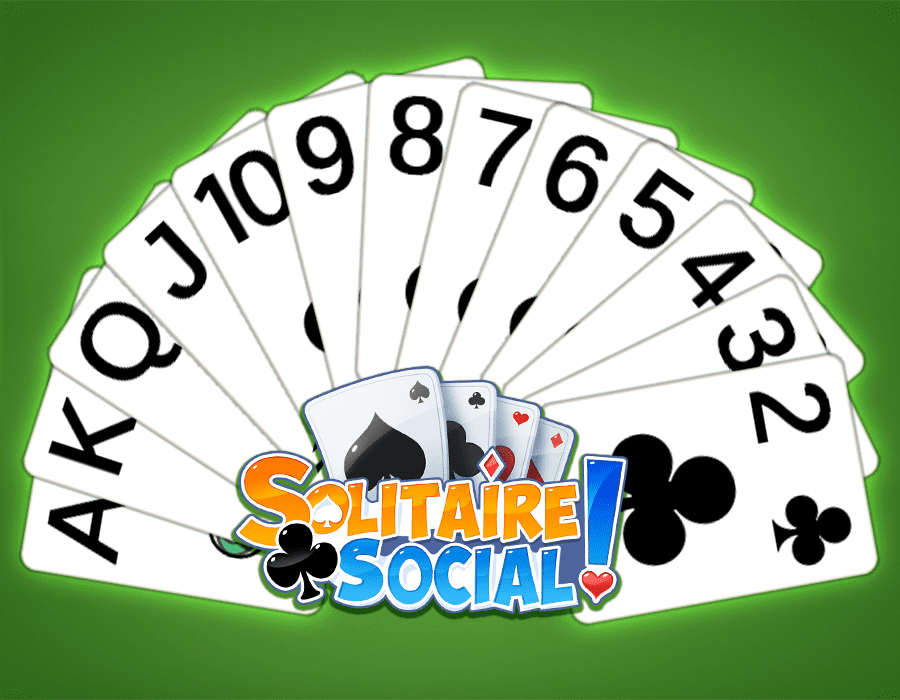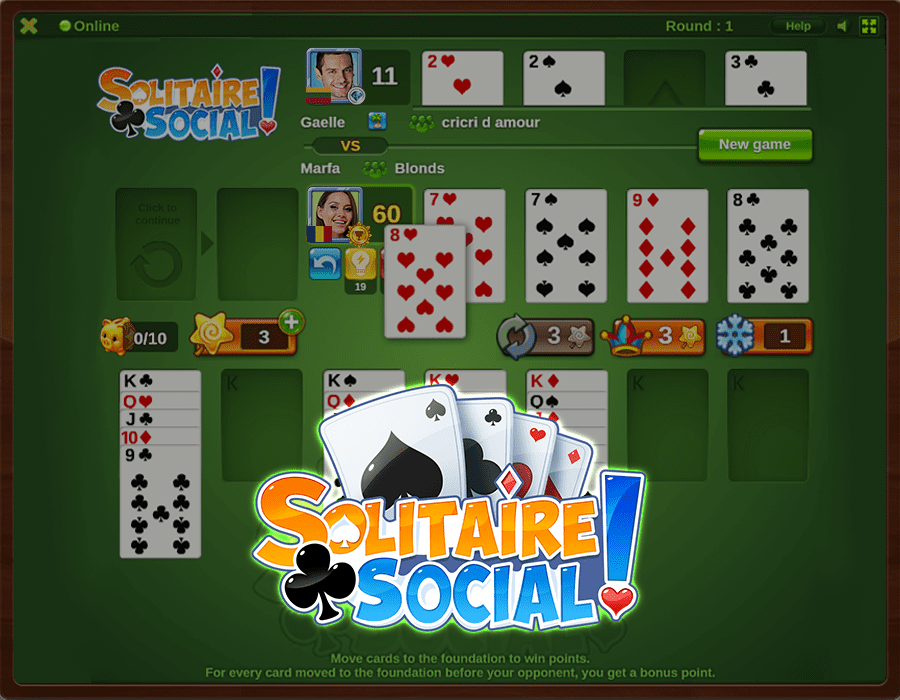
For the purposes of this article, I will cover the basic rules of solitaire and how to play the standard game, and then explain how Solitaire Social works, so you can get a feel for why it’s the best option for solitaire fans.
Before I discuss the rules of solitaire, it is important to know a few important terms.
- Tableau – The 7 groups of cards at the center of the playable space that serves as the focus of the game
- Foundations – The space at the top right corner of the play space where you will sort the different suits
- Stock – The spare cards left over that haven’t been dealt or sorted yet. When you need an extra card, it will come from the stock.
- Talon – Also called the “waste pile”, this is where you will sort cards drawn from the talon that cannot be placed anywhere on the tableau.
With these terms in mind, we can begin.

The ultimate goal of solitaire is to sort the entire deck into its respective 4 suits in cards, or “foundations”. To do this, you will have to transfer cards from the tableau, in ascending order, and in alternating colors. That means the ace goes down first, and the deck will be capped off with the king.
With your tableau set up, you can begin to transfer cards. The first card that needs to go down in each foundation will be the ace card, so you’ll want to move and stack cards to find those. On the tableau, you are able to make and shift piles, but the rules for this are different from the foundations. Tableau piles are not determined by suit, but by ranking and color. Here is the ranking for each type of card in the deck.
King, Queen, Jack, 10, 9, 8, 7, 6, 5, 4, 3, 2, Ace 
When interacting with the tableau, say you have a black 6 in a pile, and you draw a red 7. You couldn’t place it on top of that black 6, but if you find a red 5, that can go there. Your tableau piles will be in descending order, the opposite of your foundation piles.
Moving face-up cards from one place to another is the best way to reveal the card below it, which will be face down. When you’ve cleared one of the piles in the tableau, you can place a king in that space to start forming a new descending order stack.
You’ll quickly reach a point where you aren’t able to make any moves with what is available on the tableau. This is when you start drawing from the stock. In order to win, you’ll need to sort all of the cards, even in the stock, so the sooner you start working on that, the better. If you draw a card from the stock but aren’t able to use it, it goes to the talon.
That’s how the game is played. You’ll continue to build stacks on the tableau and sort the appropriate cards into their foundation deck as you find them. If you manage to sort everything into their foundations, you win! If no more moves can be made, you’ve run out of cards in the stock, and you weren’t able to build the foundations, you lose.
Setting up Solitaire
Solitaire’s popularity over the centuries it has been around can probably be attributed to its simplicity. It’s not very demanding of resources or time. It was designed to be played by a single person with a deck of cards. Any pack of standard 52 card decks will do, there’s no need for anything fancy. Other than that, you’ll need a table or flat surface of some kind, and patience.
As a matter of fact, that last piece is so important that the original name for the solitaire card game was patience! That’s what it was called by its creators, as they felt that the game itself was a test of your patience. The term solitaire only took hold after the game was popularized in North America.
Anyways, with your cards in hand and ready to go, you can begin. Make sure that the table or surface you are playing on is level, as an uneven surface will cause your stacks of cards to slide right off if the angle is drastic enough. If you decide to play outside, make sure it isn’t too windy, or you’ll want to find some sort of covered area to block that wind. I can’t imagine anything worse than having your hard work blown away in an instant.
How to set up solitaire with cards? With your deck of cards, all you have to do is lay out 7 piles of cards (I will cover how to deal these stacks in the next portion), make sure you have space for your 4 foundation piles, and lastly, you’ll need space for your stock and talon piles. That’s it. Once you have that, you’re ready to begin playing solitaire!
Dealing Solitaire
Perhaps the most confusing part of solitaire is setting up the 7 piles of cards for your tableau. To start, you should shuffle your deck of cards. Then, you will place 1 card face up, and 6 more face down in a row, so that each card is parallel to the other. This will be the base for your tableau piles.
The next row will skip the space under your first face-up card, and you’ll place the next card face up, followed by 5 more face down in a row on top of the previous row. The next row will skip the first two spaces and start on the third with a face-up card followed by 4 face-down cards. Each successive row will follow this pattern, until the final row which consists of a single face up card.
Once you have your 7 columns, the cards you have leftover become your stock, and they typically go in the top left portion of your play area. The rest of the piles are not dealt and will be formed as you play.
The only time you’ll need to deal cards during play will be when you need a card from the stock. This part is interesting, as there are two accepted ways to do this. The first, and most obvious, is to draw a single card. This will ensure minimal waste while making it easy to continue to play. The second way is to deal three cards from stock every time you draw. This is the most common way dealing from stock is done, but unused cards end up in the talon pile.
This last way saves time, and your odds of getting usable cards are much better with three cards instead of one, but you’re free to proceed however you like. Solitaire is a solitary game, so there is no one to argue about rules with besides yourself!
Solitaire Social is an evolution of the legendary card game. Instead of playing by yourself, Social Solitaire pits you against another live player with the exact same deck, all of the cards in the exact same order. Your goal is to finish sorting that deck before the other player, which will earn you a win!
What’s even better is that Solitaire Social follows the rules of basic solitaire as outlined above. It maintains the simplicity of the game while adding features on top that make it more fun for everyone. For instance, the game provides you with several power-ups that you can use to gain the upper hand over your opponent when you’re losing steam.
For the true kings and queens of solitaire, see how you stack up against players around the world with the Solitaire Social leaderboards. You can even participate in tournaments to flex your solitaire skills and win coins.
If you’re new to solitaire, you’ll earn daily prizes just for logging in and playing. This is a great way for you to learn the ropes and get on your feet in the world of Solitaire Social. Everybody has to start somewhere, and you’ll be slinging cards with the best of them in no time!
In between intense games with international solitaire pros, you can relax and hang out in your own virtual garden. Unlocked after 5 tournament wins, the garden is the first of several locations that you can spruce up with decorations and other things to increase its beauty rating. This is a whole additional game on top of the solitaire, adding hours upon hours of extra fun. 
If you’ve ever encountered a deck of playing cards, you’ve probably played or seen someone play solitaire. The classic game has been enjoyed by people for centuries, as it is believed to have been invented in the late 1700s or early 1800s.
It has its origins in Europe and Scandinavia, where it quickly spread like wildfire. Notable historic figures like Napoleon and Prince Albert were known as solitaire aficionados. Especially Napoleon, as he spent many of his lonely days in exile playing the card game to pass the time.
By the 1870s, solitaire had made its way to North America and become ingrained in the culture. In fact, the first book about the solitaire card game, Patience: A Series of Thirty Games With Cards, was published in 1870. From that point, solitaire was a popular pastime for many.
The age of computers, instead of replacing the ancient card game, merely added another option of play for its many fans. A digital version of solitaire was built into the Microsoft Windows operating system throughout the 1990s, known as Microsoft Solitaire.
In the modern-day, many still enjoy solitaire using a physical deck of cards. But, there is a better way to play solitaire, one that can connect you with family and friends and allow you to enjoy your favorite card game, no matter how far apart you are. All of this is possible through Solitaire Social, an online multiplayer solitaire card game.
- Solitaire for newbies
- April 11, 2022



